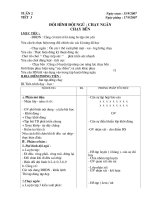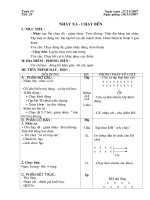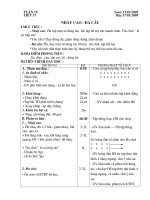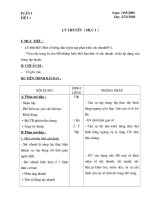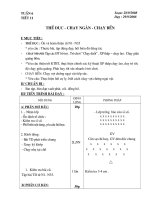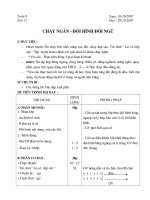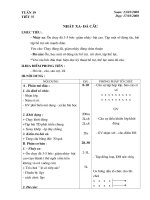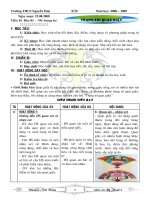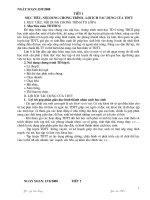Giao an 8 ca nam
Bạn đang xem bản rút gọn của tài liệu. Xem và tải ngay bản đầy đủ của tài liệu tại đây (829.21 KB, 178 trang )
Period 1
INTRODUCE
THE COMPONENTS OF THE TEXT BOOK
Teaching date
Class
.............................. 8A
............................. 8D
I. Objectives
- By the end of the lesson, Ss will be able to know the basics of each unit. Help Ss learn
actively. T guides Ss how to learn in each section
II. Preparation
1. Teacher: Text book, teaching plan.
2. Students: Text book.
III. Procedure
Teacher’s and students activities
Contents
1. Oral test (0’)
- How are you?
- In the new lesson
- What’s the weather like today?
2. New lesson: (40’)
- Do you have enough text book?
* Warm up: Chatting
........................................................
T: Asks Ss some questions
* The new English 8 book.
Ss: Answer the teacher
- There are 12 main units. Each unit has
eight sections. At the beginning of every
unit, there are explicit learning contents
clearly starting the main language and
skills to be taught in the unit.
- T: Introduces Ss the new text book for
English 7
- T: Asks Ss to take out their books.
- Ss:Take out the books.
- T: Introduces about the book. ( The main
sections)
- Ss: Open the book and check the sections
following the teacher guide.
- T: Guides Ss to how to learn in each
section.
Section1: Getting started; Section 2: A
closer look 1; Section 3: A closer look 2;
Section 4: Culture and communication;
Section 5 Skills 1; Section 6: Skills 2;
Section 7: Looking back and project.
Section 1: Learn the conversation:
Including vocabulary, grammar items
Section 2: Practise vocabulary,
pronunciation.
Section 3: Main grammar of the unit
Section 4: The funtional language. Cultural
- Ss: Listen to the teacher.
knowledge of VN and other countries
- T: Teaches Ss some commands and
activities in class
Section 5: Reading & speaking skill.
- Ss: Make acquainted with class
commands and activities.
3. Consolidation (3’)
- T: Reminds the knowledge
Section 6: Listening & writing skill
Section 7: Improve ability.
*Commands and activities:
- Look at the board
- Open/ close your book
- Read after me
- Work in pairs/ group....
4. Homework (2’)
- Prepare unit 1 (Getting started) in advance.
Teaching date
Class
UNIT 1: LEISURE ACTIVITIES
Period 2: Getting started
........................
........................
……………….
………………..
………………..
8A
8B
8C
8D
8E
I. Objectives
By the end of the lesson, students can:
- use the lexical items related to the topic of leisure activities.
1. Knowledge:
- Vocabulary: items related to the topic ‘Leisure activities’
2. Skills:
Listening, speaking, reading and writing
3. Attitude:
To educate the students to love their traditional crafts in Viet Nam.
II. Preparation
1. Teacher: Computer; Pictures in soft book
2. Students: Getting Started
Teacher’s and students activities
Contents
1. Oral test
- In the new lesson
2. New lesson
* Warm up: 5’
T: T: Asks Ss to open their books and
look at the pictures and the title under
GETTING STARTED. Ask them
some questions:
Look at the picture and answer the T’s
question:
What can you see in the picture?
Why do you think Mai, Phuc, and Nick
are there?
1.Listen and read
Act 1: 10’
-Play the recording and have Ss follow
along.
New words
- strick(n): mẹo
- folk songs(n):bài hát dân ca
a. Circle the correct answer.
-Ss can compare their answers with the
1. bookstore 2. book
information in the dialogue and add
some more details to their answers.
3. do
4. craft kit
-Ss work individually to circle the 5. folk music 6. Vietnamese
correct answer. Ss compare their
answers with a partner and then b.Which leisure activities do you think
Phuc, Mai, and Nick have? Tick ( ) the
discuss as a class.
boxes.
-T goes through each statement and
asks Ss how the text and the visual in
the dialogue support their answers.
-T writes the correct answers on the
board.
1.pet training: Phuc
2.making crafts: Mai
3.reading: Phúc, Nick
4.listening to music: Nick
c.Answer the questions.
-T encourages Ss to explain what they
are and to give examples.
-T:Draws Ss’ attention to the contexts
when Mai said ‘Check out this book’
and Phuc said ‘It’s right up your
street!’. Together with Ss elicit the
meaning of these two expressions.
Act 2: 25’
-Ss work in pairs to match the words/
phrases in the box to the photos, then
they listen together to check their
answers.
2.Find words/ phrases in the box to
describe the photos. Then listen to
check your answers.
1. playing computer games
- Ss work individually to do the task
then compare their answers with a 2. playing beach games
partner.
3. doing DIY
4. texting
-T:Tell Ss they need to look for the
surrounding keywords in order to
complete the task. Note that ‘good’
and ‘satisfied’ fit both items 1 and 5.
3. Consolidation(3’)
- Remind the lexical items related to
the topic of leisure activities.
4.Homework(2’)
- Do activity 4, learn by heart the new words.
UNIT 1:
LEISURE ACTIVITIES
Period 3: A CLOSER LOOK 1
Teaching date
........................
........................
………………
………………
………………
Class
8A
8B
8C
8D
8E
I. Objectives
By the end of the lesson, students can:
- use the lexical items related to the topic of leisure activities.
in context
1. Knowledge:
- Vocabulary: items related to the topic ‘Leisure activities’
2. Skills:
Listening, speaking, reading and writing
3. Attitude:
To educate the students to love leisure activities.
II. Preparation
1. Teacher: Computer; Pictures in soft book
2. Students: A closer look 1
III. Procedure
Teacher’s and students activities
1. Oral test
Contents
- In the new lesson
2. New lesson
* Warm up: 5’
- T: Asks some questions.
T: Act 1: 10’
-T: Asks Ss to work in pairs to examine
the pie chart closely in order to
understand its contents, including the
heading,subheadings,figures,colour codes,
source, and notes.
Act 2: 5’
- What is the pie chart about? Where can
you find the information?
I.Vocabulary
1.Look at the following pie chart on
leisure activities in the US and answer the
questions.
1.In 2012, people in the US spent 5.1 hours
a day on sports and leisure activities.
2.The main activities they did include
watching TV, socializing and
communicating, reading, participating in
sports and exercise, using computers for
leisure, relaxing and thinking.
2. Complete the table with information
Have Ss work individually to complete from the pie chart.
the task. (e.g. relaxing comes from the
verb relax with –ing added, and it refers
to the activity).
-T: asks Ss to cover the category labels.
Name of activity Verb
relaxing
thinking
using
doing
watching
reading
socialising
communicating
relax
think
use
do
watch
read
socialise
communicate
Act 3: 5’
- Have Ss work individually to
complete this task. Once they have
finished.
- Ss work in pairs to compare their
answers.
Act 4: 15’
- T helps Ss to practice clusters /br/ & /pr/
3. Look at the words. Match them to the
category labels.
1.e 2. B 3. F 4. A 5. D
II. Pronunciation
Clusters: /br/ and /pr/
5. Complete the words under the pictures
with /br/ or /pr/. Listen to check your
answers and repeat.
3. Consolidation(3’)
- Pronounce words containing the
clusters /br/ and /pr/ correctly in
isolation and in context
4.Homework(2’)
- See “A closer look 2” before.
1. apricot
2. bridge
3. bracelet
4. bread
5. Princess
6. president
6.Listen and repeat.
Teaching date
........................
........................
……………….
……………….
……………….
UNIT 1
LEISURE ACTIVITIES
Period 4: A CLOSER LOOK 2
Class
8A
8B
8C
8D
8E
I. Objectives
By the end of the lesson, students can:
- use the lexical items related to the topic of leisure activities.
1. Knowledge:
- Vocabulary: items related to the topic ‘Leisure activities’
2. Skills:
speaking and writing
3. Attitude:
To educate the students to love leisure activities.
II. Preparation
1. Teacher: Computer; pictures in soft book
2. Students: A closer look 2
III. Procedure
Teacher’s and students activities
Contents
1. Oral test
- In the new lesson
2. New lesson
* Warm up: 5’
- T: Asks some questions:
- What is the pie chart about? Where can
you find the information?
- What do the different coloured sections
of the chart refer to?
- How are these sections calculated?
*Grammar
Act 1: 10’
-T:Reminds Ss of the concept of the
gerund from A CLOSER LOOK 1. Ask
them how the gerund is formed and how it
functions grammatically.
- I love to watch him …
Verbs of liking + gerunds/to - infinitive
1.Read the conversation in Getting
Started again. Underline verbs that
are followed by a gerund.
love (to watch)
- But I think I’ll enjoy listening …
enjoy (listening)
- T: Explains that in English if we want to
liked (reading)
follow a verb with another action, we must
use a gerund or an infinitive
-T: Introduce Ss to the Learning tip box,
where they can differentiate the difference
in terms of degree these verbs of
liking/disliking.
2.Tick (√ ) the appropriate box. Then
listen to check.
followed followed
- Ss work in pairs to complete this task,
by
byboth
then T gives feedback to Ss as a class.
gerund
gerund
only
andto- infi
1.love
√
- Have Ss quickly familiarise themselves
with the email by asking:
2.enjoy
√
Act 2: 10’
3.detest
√
4.prefer
5.fancy
√
√
Act 3: 5’
- T asks Ss to write the correct form of the
verbs.
- Ss write the correct form of the verbs
Act 4: 10’
T asks Ss to write sentences about what
you like or don’t like doing in your free
time, beginning with the following. Then
share what you have written with your
partner.
3. Write the correct form of the verbs.
1. making
2. to watch/watching
3. skateboarding
4. to learn/learning
4.Write sentences about what you like or
don’t like doing in your free time,
beginning with the following. Then share
what you have written with your
partner.
like do → like to do/ like doing
enjoy do → enjoy doing
don’t like have → don’t like to have/don’t
like having don’t mind to do → don’t mind
doing
5. Look at the following email that Minh
Duc wrote to a new pen friend.
The activities Duc mentions in his
email are: playing video games,
3. Consolidation(3’)
- Remind the way of using the verbs of
liking that are followed by gerunds/ toinfinitives
4.Homework(2’)
- See “Communication” in advance
watching TV, going to the park,
playing football, helping his parents,
doing homework, and eating out
with his family.
UNIT 1
LEISURE ACTIVITIES
Period 5: COMMUNICATION
Teaching date
........................
........................
………………
………………
………………
Class
8A
8B
8C
8D
8E
I. Objectives
By the end of the lesson, students can:
- use the lexical items related to the topic of leisure activities.
1. Knowledge:
- Vocabulary: items related to the topic ‘Leisure activities’
2. Skills:
speaking and writing
3. Attitude:
To educate the students to love leisure activities.
II. Preparation
1. Teacher: Computer; Pictures in soft book
2. Students: Communication
III. Procedure
Teacher’s and students activities
Contents
1. Oral test
- In the new lesson
2. New lesson
* Warm up: 5’
- T: Asks some questions
- What is the pie chart about? Where can you
find the information?
- What do the different coloured sections of the
chart refer to?
Act1: 15’
T: Elicits words from Ss
Rub out and remember
Extra vocabulary
. window shopping: đi chơi ngắm đồ bày bán
trong cửa hàng
-T:Explains to Ss that they are going to
read about some activities teenagers do to be hooked on something:yêu thích cái gi
in their spare time.
to sound weird: nghe kỳ cục
-T:sets a reading time limit and have Ss
to be addicted to something: nghiện cái gi
speed read the text.
-T:Asks Ss if they notice any other
1. Read the following article on the
particular features of the text.
magazine 4Teen website
Act 2: 20’
- Ss work in small groups to complete
the table. Allow Ss to read the text more
closely to fill in the table
2.Can you understand the abbreviations in
the text? Use this ‘netlingo’ dictionary if
necessary.
3.Find information in the text to complete the
table.
Who?
Emily
3. Consolidation(3’)
- Remind the way of using the verbs of
liking that are followed by gerunds/ toinfinitives
4.Homework(2’)
- See “Skills 1” in advance
What
activiy
is
mentio
ned?
hanging out
with friends
(window
shopping
working as a
volunteer
What does
he/she think of
it?
She
loves
it.
Hang
cloud
watchi
ng
She
adores
it. It’s
easy.
She
loves
it.
Linn
• going to
community
centre,
painting,
dancing, doing
drama
Minh
playing
football
helping his
aunt in
running
cooking
classes
He likes it.
It’s fun.
Manuel
playing
computer
games
• doing judo
He’s addicted
to it.
It’s OK.
Teaching date
........................
........................
………………
………………
………………
UNIT 1
LEISURE ACTIVITIES
Period 6: Skills 1
I. Objectives
By the end of the lesson, students can:
- use the lexical items related to the topic of leisure activities.
of using computers.
-talk about ‘good’ and ‘bad’ sides of leisure activities
1. Knowledge:
- Vocabulary: items related to the topic ‘Leisure activities’
2. Skills:
Reading and speaking
3. Attitude:
To educate the students to love leisure activities.
II. Preparation
1. Teacher: Computer; Pictures in soft book
2. Students: Skills 2
III. Procedure
Teacher’s and students activities
1. Oral test
Class
8A
8B
8C
8D
8E
Contents
- In the new lesson
2. New lesson
* Warm up: 5’
- T: Asks some questions.
1.What are the benefits of using
computers or mobile phones for leisure
activities? What are the harmful things
it may bring us?
T Act 1: 15’
*Pre - reading
T: Elicits words from Ss
Rub out and remember
-T:Starts the lesson by doing a quick class
survey on how many Ss use computers
frequently and what they use them for
2. Read the text and choose the correct
* While - reading
answer.
-Ss work in pairs to discuss the questions.
1.B 2.C
-Ss: pairs to share their ideas once they have
finished their discussion. Write the ideas on
the board.
3.Write the questions for the
answers based on information
from the text.
1.Is Quang’s garden real?
2.What is the problem with using
-T:Tells Ss for this exercise they will need to technology in your free time?
look at the keywords in the responses in 3.What leisure activities do teenagers do
these days?
order to find out the questions.
-Ss work individually then compare their
answers with a partner.
Act 2: 20’
II. Speaking
Quang and his parents are talking
-T:Explains to Ss that these speech bubbles about how he should spend his free
are from Quang and his parents. Ss may work time.
in pairs or in groups, but they will need to
say why they think who says what, based on
the information from the passage.
-T:Asks Ss to look at the title and the picture
and predict what they are going to read. Say
that they are going to read about a student
named Quang.
* Post - reading
-In pairs, have Ss choose a speech bubble and
combine it with the language in the
3. Consolidation(3’)
- ‘good’ and ‘bad’ sides of leisure activities
4.Homework(2’)
- See “Skills 2” in advance.
UNIT 1
Teaching date
........................
Class
8A
LEISURE ACTIVITIES
Period 7: Skills 2
........................
……………….
……………….
……………….
8B
8C
8D
8E
I. Objectives
By the end of the lesson, students can:
- listen for specific information about ways of spending time with friends.
1. Knowledge:
- Vocabulary: items related to the topic ‘Leisure activities’
2. Skills:
Listening and writing
3. Attitude:
To educate the students to love leisure activities.
II. Preparation
1. Teacher: Computer; Pictures in soft book; Helping Board
2. Students: Help
III. Procedure
Teacher’s and students activities
Contents
1. Oral test
- In the new lesson
2. New lesson
* Warm up: 5’
- What do you usually do in your free
time?
- T: Asks some questions.
T Act 1: 15’
*Pre - listening
T: Elicits words from Ss
Rub out and remember
-Ss: Share some of the things they often
enjoy doing with friends in your free
time.
I. Listening
* New words
- popcorn(n): bỏng ngô
- physical health: thể lực
1.What do you usually do with your
friends in your free time?
2.Listen to the radio programme and
answer the questions.
1.The topic of this week’s programme is
-T:Tells Ss that they are going to listen to hanging out with your friends.
a radio programme. Ask them to look at
2.There are two main ways: hanging out
the questions and underline the keywords
indoors or outdoors
before T plays the recording.
* While - listening
-T:Plays the recording as many times as
needed.
3.Listen again and complete the table.
* Post – listening
1. movies
2. Cinema
- Ss retell the contents of the listening.
4. sports
Act 2: 20’
II. Writing
Writing to give an opinion
3. crafts
5. physical health
-Have Ss cover the box and write some of 4.Writing to give an opinion
these words/ phrases on the board.
- T:Asks Ss where in a paragraph they 1.In my opinion/I believe
often see these words and what could be 2.Firstly
the purpose for using them.
3. Secondly
4.Besides/Also/In addition
5.Now write a similar paragraph to
answer one of the following questions.
Sample:
3. Consolidation(3’)
-Remind: the specific information
specific information about ways of
spending time with friends.
I believe the best leisure activity for
teenagers is any group activity. This
could be playing a team sport or
joining a hobby group or even
volunteering. Firstly, teenagers like to
feel that they belong to a group.
Secondly, being part of a group helps
teenagers make friends. Friendships
are very important to teenagers. In
addition, they will make friends with
people who have the same interests as
them.
4.Homework(2’)
- See “Looking back and Project” in advance
UNIT 1
LEISURE ACTIVITIES
Teaching date
........................
Class
8A
Period 8: Looking back and Project
I. Objectives
By the end of the lesson, students can:
- Review all the knowledge in unit 1.
1. Knowledge:
- Vocabulary: items related to the topic ‘Leisure activities’
2. Skills:
Speaking and writing
3. Attitude:
To educate the students to love leisure activities.
II. Preparation
1. Teacher: Computer; Pictures; Extra board
2. Students: Project
III. Procedure
Teacher’s and students activities
1. Oral test
........................
………………
………………
………………
8B
8C
8D
8E
Contents
- In the new lesson
2. New lesson
* Warm up: 5’
- What do you usually do in your free
time?
- T: Asks some questions.
TAct1: 5’
I.Vocabulary.
-Ss complete this exercise individually or 1.Which one is the odd one out?
in pairs. -Ss complete this task
1. DIY
2. hanging out
individually.
3. hospital
4. detest
2. Rearrange the letters to find the name
of the activities.
2. relaxing
-Ss work individually to complete the 1. socialising with friends
exercise. If time allows,
-T asks Ss to swap their work with each 3. communicating with friends 4. doing
DIY
other for peer correction.
Act 2: 5’
5. using computers
-Ss work individually then compare their
answers with a partner
6. making crafts
Act 3: 15’
II.Grammar
T asks Ss to do the activities 3,4,5.
3. Fill the gaps with the correct form of
the verbs.
Ss work in small groups
1. working
3. seeing
2. learning/to learn
4. doing
4. Complete the following sentences
with your own ideas.
5. Read this paragraph from by CEOP,
the UK government agency that helps
protect children from harm online and
offline in the UK and internationally.
1. Firstly
2. Secondly
3. Thirdly
Act 4: Project (10’)
- T asks Ss to talk about the leisure
activities
3. Consolidation(3’)
- Remind the Grammar and vocabulary in
this unit
4.Homework(2’)
- See “getting started – unit 2” in advance
4. In addition
5. In short
III. Communication
6. Choose from the leisure activities in
this unit:
* Project( If have time)
UNIT 2
LIFE IN THE COUNTRYSIDE
Period 9: Getting started
Teaching date
........................
........................
……………….
……………….
……………….
Class
8A
8B
8C
8D
8E
I. Objectives: By the end of the lesson, students can:
- Use the lexical items related to the topic of life in the countryside
1. Knowledge:
- Vocabulary: the lexical items related to the topic of life in the countryside
2. Skills:
Listen and read
3. Attitude:
To educate the students to love the life in the countryside.
II. Preparation
1. Teacher: Computer; Extra board; Pictures in soft book
2. Students: Pictures
III. Procedure
Teacher’s and students activities
Contents
1. Oral test
- In the new lesson
2. New lesson
- What is the conversation about?
- What do you think the countryside is like
-T:Asks Ss to look at the title of the
at harvest time? What do the farmers do?
conversation and the picture and ask them
some prediction questions about what they
are going to read.
1. Listen and read
T *Act1: 10’
* Warm up: 5’
-T: Asks ss to work independently. Ask *New words
them to read the sentences and decide if
herd(v): chăn (trâu)
they are true or false.
-T writes the correct answers on the board.
envious(adj): ghen ty
-T: Asks Ss to look at the words in the box
and make sure they understand their
meanings.
- T:asks them to do the exercise. When
they finish, ask them to check their
a. Are these sentences true (T) or
false (F)?
1.T 2.F 3.F 4.T
b.Answer the following questions.
answers with their partner.
1. He’s in the countryside
2. Right on his first day there.
- Have Ss work in small groups to discuss
and tick the correct box and look for 3. It’s big and colourful.
expression(s) to support their answer.
4. His grandfather
5. Yes, he does.
c.Complete the sentences with the words
in the box.
1. colourful
2. move slowly
3. harvest time
4. paddy field
5. herding
6. buffalo-drawn cart
d.In groups, discuss and find how Nguyen
feels about his stay in the countryside.
Tick the appropriate box.
Suggested answers:
He likes it.‘… it’s more exciting than I
expected.’
‘It (the kite) looks great up there in the sky.’
‘I live more happily here, and there’s still a
lot more to explore.’
Act 2
2.Match the activities with the pictures.
- Ss work independently to label the
pictures. Have them compare their answers Key: 1. e
with a partner. T writes the correct answers
on the board.
3. Consolidation(3’)
- Remind the lexical items related to the
topic of life in the countryside
4.Homework(2’)
- Do ex 3,4(textbook)
- See “A closer look 1 – unit 2” in advance
2. f
3. a
4. c 5. d
Teaching date
........................
........................
……………….
………………..
………………...
UNIT 2
LIFE IN THE COUNTRYSIDE
Period 10: A closer look 1
Class
8A
8B
8C
8D
8E
I. Objectives
By the end of the lesson, students can:
- use the lexical items related to the topic of life in the countryside
- pronounce correctly words containing the clusters /bl/ and /cl/
1. Knowledge:
- Vocabulary: the lexical items related to the topic of life in the countryside
2. Skills:
Listening and speaking
3. Attitude:
To educate the students to love the life in the countryside.
II. Preparation
1. Teacher: Computer; Extra board; Pictures in soft book
2. Students: Vocabularies
III. Procedure
Teacher’s and students activities
1. Oral test
Contents
- In the new lesson
2. New lesson:
- What is the conversation about?
- What do you think the countryside is like
-T:Asks Ss to look at the title of the
at harvest time? What do the farmers do?
conversation and the picture
I.Vocabulary
T* Act1: 15’
* Warm up: 5’
-Ss listen to the recording and repeat the 1. Listen and repeat the words.
words. Make sure that they pronounce the 1. slow
2. colourful
words with the correct stress patterns.
3. friendly 4. hard
-Ss work individually. Ss compare their 5. brave
6. boring
answers with a partner and then discuss as
2. Put the words in into the appropriate
a class.
category. Some words can be used in
more than one category.
-T:Makes sure Ss understand the meanings people: friendly, brave, boring, nomadic,
colourful
of the verbs first.
-T elicits the correct answers.
Life: slow, hard, boring, inconvenient,
peaceful, nomadic,
- Ss use the vocabulary they have learnt in
and ( for adjectives and for verbs) to do scenery:colourful, vast, peaceful
this exercise. Ask Ss to look at the
sentences and decide if an adjective or a
verb is missing.
3. Match the nouns/ noun phrases in the
box with each verb.
ride: a horse, a camel
put up: a tent, a pole
collect: hay, water
herd: the buffaloes, the cattle
4. Use the words in and to complete the
sentences. Remember to use the correct
form of the verbs.
1. picking
2. inconvenient, collect
*Act 2: 15’
3. herd
4. ridden, brave
5. peaceful
6. Nomadic
II. Pronunciation
-Ss listen and repeat. Pause the recording Clusters: /bl/ and /cl/
to drill difficult items. Have Ss say the
words individually or in small groups.
5.Listen and repeat the words. Pay
attention to the initial clusters.
1. blackberry
2. clothing
- Have Ss look at the sentences and
3. climb
4. blind
underline the words with clusters /bl/
and /cl/ first. Ss then listen and repeat.
5. click
6. clay
6. Listen and circle the words you hear.
1. The wind is blowing so hard
2. These people have climbed to the top of
the mountain
3. Consolidation(3’)
- pronounce correctly words containing the
3. The tree is in full bloom
clusters /bl/ and /cl/
4.Homework(2’)
- See “A closer look 2 – unit 2” in advance
pronounce correctly words containing the clusters /bl/ and /cl/
use the lexical items related to the topic of life in the countryside
use comparative forms of adverbs of manner
read for specific information about an unusual lifestyle in the countryside
talk about what they like or dislike about life in the countryside
listen for specific information about changes in the countryside
write a short paragraph about changes in the countryside
UNIT 4
Teaching date
Class
OUR CUSTOMS AND TRADITIONS
Period 25: Getting started
........................
……………….
……………….
........................
……………….
8A
8B
8C
8D
8E
I. Objectives
By the end of the lesson, students can:
-Use the lexical items related to the topic ‘customs and traditions’
1. Knowledge:
- Vocabulary: items related to the topic ‘customs and traditions’
.
2. Skills:
Listening, speaking, reading and writing
3. Attitude:
To educate the students to love their customs and tradition.
II. Preparation
1. Teacher: Computer; Pictures in softbook
2. Students: Getting Started
III. Procedure
Teacher’s and students activities
Contents
1. Oral test
- In the new lesson
2. New lesson
* Warm up: 10’
T T: Asks Ss to open their books and Look at the picture and answer the T’s question:
look at the picture and the title
under GETTING STARTED. Ask + Who can you see in the picture?
them some questions:
+ What do you think the people in the picture are
talking about?
-Ss answer the questions as a class.
Play the recording and have Ss
follow along.
Asks Ss to look at the picture in
student’s book.
Ss: Look at the pictures and answer
the questions
* Vocabulary: 5’
* Vocabulary
T: Elicits words from Ss
aharp(adv) chính xác, đúng
Rub out and remember
accept (v) : chấp nhận
You ‘re kidding( idom): Bạn cứ đùa thế thôi!
Act 1: 15’
1. Listen and read
-Ss work independently to find the a)Find a word/ phrases that means:
words/phrases in the dialogue.
Key: 1. Accepted 2. Generations
Allow them to share answers
before discussing as a class.
3. spot on
4. Sharp
- Have Ss look at the Watch out!
box and quickly read the
information.
b) Tick true (T) or false (F).
You must be joking
1. T 2. F(There are also social ones)
3. T
4. F( There are a lot of customs for table
mannersin the UK)
Key:
read the questions to
they understand them. 1.It’s eating dinner at 7 p.m. sharp.
firstly to answer the 2..He’s surprised.
3.They both refer to doing something that develops
without reading the
over time.
4.A custom is something accepted. A tradition is
something special and is passed down through
- Ss exchange their answers with a
the generations.
classmate.
5.They should find information about a custom or
- Ss read the conversation again to tradition.
do this exercise. Ask for Ss’
answers as well as the explanations
for their choices. Write the correct
answers on the board.
Key:
Act 2 : 10’
1.g
2. c
3. f
4. h
- T: Have Ss look at the pictures.
5. e.
6.a
7. B
8. d
Ask them what they see in each of
them. Now tell Ss that in the box
are some customs and traditions of
Vietnamese people.
-Have Ss
make sure
Ask them
questions
dialogue.
-Ss read these and identify any new
words they do not know. Explain

